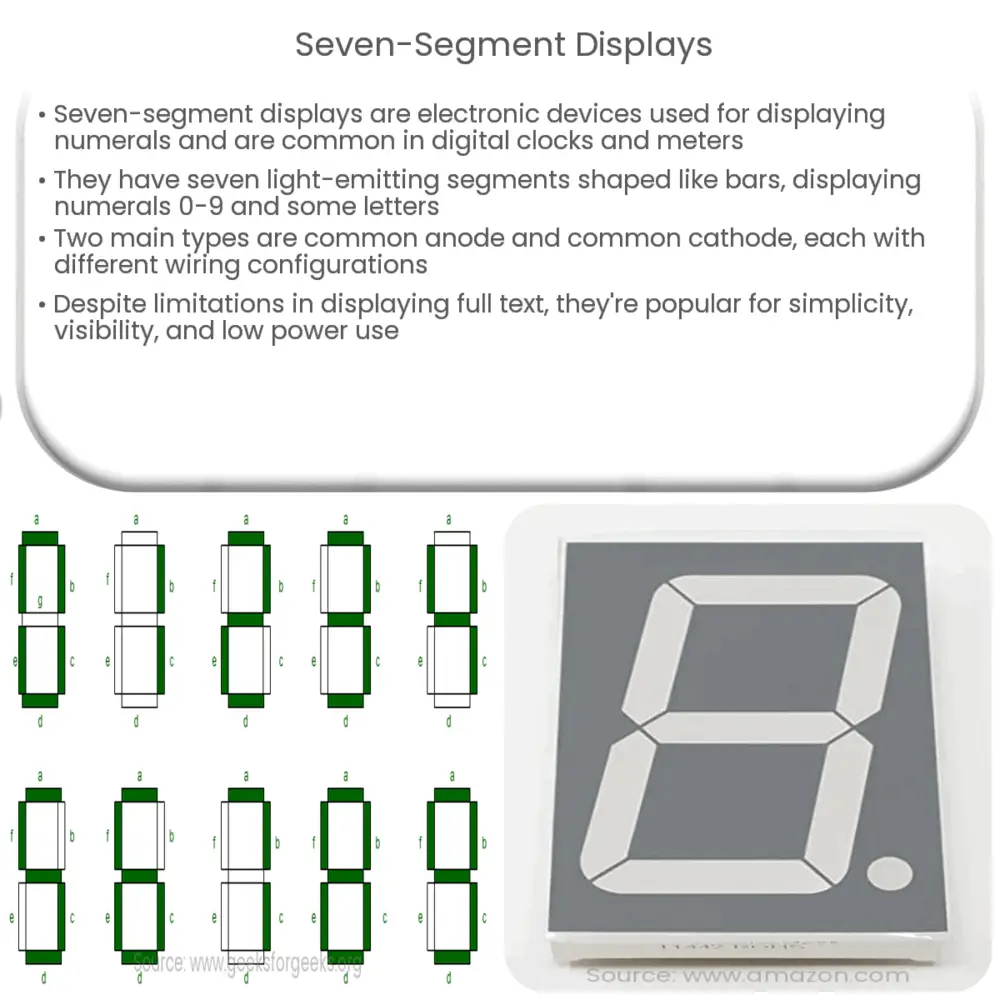Explore the workings, types, applications, pros, and cons of seven-segment displays, commonly used in digital clocks, meters, and calculators.

Introduction to Seven-Segment Displays
Seven-segment displays are a type of electronic display device for displaying decimal numerals. They are widely used in digital clocks, electronic meters, and other electronic devices for displaying numeric information.
Structure and Functioning
A seven-segment display consists of seven segments of light-emitting diodes (LEDs) or liquid crystal display (LCD) elements, arranged in a specific pattern. Each segment is shaped like a ‘bar’, hence the name ‘segment’. The arrangement allows for the display of numerals 0-9 and a limited set of letters of the alphabet.
The seven segments are labeled from A to G, with A at the top and G in the middle. Each segment can be lit individually or in combination with others to represent a specific numeral or character. When a segment is ‘on’, it emits light (or blocks light in the case of LCD), making it visible, while it is invisible or dark when ‘off’.
Different Types of Seven-Segment Displays
There are primarily two types of seven-segment displays: common anode and common cathode. In a common anode display, all the LED segment anodes are connected together, and the individual segments are controlled by supplying a ground, logic ‘0’ or negative supply to the LED segment’s cathode. Conversely, in a common cathode display, all the LED segment cathodes are common and grounded. The individual segments are lit by applying a positive supply, logic ‘1’ to the LED’s anode.
- Common Anode (CA): In this display, all the anodes (positive terminals) of the seven LEDs are connected together. The individual segments light up when a low voltage level is applied to the corresponding pin.
- Common Cathode (CC): Here, all the cathodes (negative terminals) of the seven LEDs are connected together. The individual segments light up when a high voltage level is applied to the corresponding pin.
These two different configurations allow for greater flexibility in how a seven-segment display can be used within an electronic circuit.
Applications of Seven-Segment Displays
Seven-segment displays are commonly used in a wide range of digital display applications due to their simplicity, reliability, and visibility. These include:
- Digital clocks and watches: The most common application, where each digit of the time (hours, minutes, and seconds) is displayed as a separate digit on the seven-segment display.
- Electronic meters: They are used in a variety of meters such as voltmeters, ammeters, and frequency counters to display the measured values.
- Calculators and digital adding machines: These devices often use seven-segment displays to show the input values, intermediate results, and final results of calculations.
- Temperature and pressure display panels: In various industrial and home appliances, seven-segment displays are used to show the current temperature, pressure, or other monitored values.
Advantages and Disadvantages of Seven-Segment Displays
Like any technology, seven-segment displays have their advantages and disadvantages, which must be considered when deciding whether to use them in a specific application.
Advantages
- Visibility: Seven-segment displays are highly visible and can be read from a considerable distance, and at a wide range of angles.
- Simplicity: They are simple to use and can be controlled with just a few I/O pins of a microcontroller, making them a popular choice for many applications.
- Low power consumption: LED-based seven-segment displays consume low power compared to other display technologies, making them suitable for battery-powered devices.
Disadvantages
- Limited Display: Seven-segment displays can only display digits and a limited set of letters, limiting their use in applications that require text or graphics.
- Multiple Display Complexity: When multiple seven-segment displays are used together, the wiring and control can become complex, especially if each digit needs to be controlled individually.
Conclusion
Seven-segment displays are a versatile and cost-effective solution for displaying numerical data in a variety of applications. Despite their limitations, such as their inability to display full text or complex graphics, they remain a popular choice due to their simplicity, high visibility, and low power consumption. As technology continues to advance, it’s likely that seven-segment displays will continue to evolve, finding new applications in a wide range of electronic devices.
